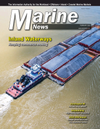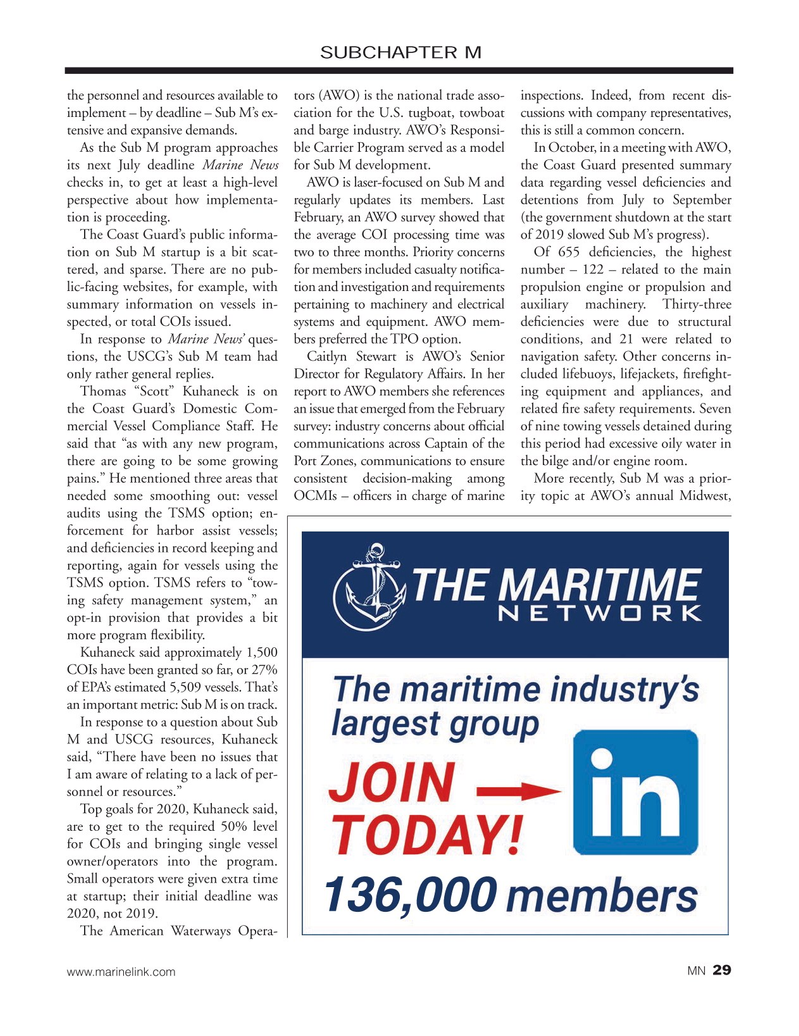
Page 29: of Marine News Magazine (February 2020)
Pushboats,Tugs & Assist Vessels
Read this page in Pdf, Flash or Html5 edition of February 2020 Marine News Magazine
SUBCHAPTER M the personnel and resources available to tors (AWO) is the national trade asso- inspections. Indeed, from recent dis- implement – by deadline – Sub M’s ex- ciation for the U.S. tugboat, towboat cussions with company representatives, tensive and expansive demands. and barge industry. AWO’s Responsi- this is still a common concern.
As the Sub M program approaches ble Carrier Program served as a model In October, in a meeting with AWO, its next July deadline Marine News for Sub M development. the Coast Guard presented summary checks in, to get at least a high-level AWO is laser-focused on Sub M and data regarding vessel de? ciencies and perspective about how implementa- regularly updates its members. Last detentions from July to September tion is proceeding. February, an AWO survey showed that (the government shutdown at the start
The Coast Guard’s public informa- the average COI processing time was of 2019 slowed Sub M’s progress).
tion on Sub M startup is a bit scat- two to three months. Priority concerns Of 655 de? ciencies, the highest tered, and sparse. There are no pub- for members included casualty noti? ca- number – 122 – related to the main lic-facing websites, for example, with tion and investigation and requirements propulsion engine or propulsion and summary information on vessels in- pertaining to machinery and electrical auxiliary machinery. Thirty-three spected, or total COIs issued. systems and equipment. AWO mem- de? ciencies were due to structural
In response to Marine News’ ques- bers preferred the TPO option. conditions, and 21 were related to tions, the USCG’s Sub M team had Caitlyn Stewart is AWO’s Senior navigation safety. Other concerns in- only rather general replies. Director for Regulatory Affairs. In her cluded lifebuoys, lifejackets, ? re? ght-
Thomas “Scott” Kuhaneck is on report to AWO members she references ing equipment and appliances, and the Coast Guard’s Domestic Com- an issue that emerged from the February related ? re safety requirements. Seven mercial Vessel Compliance Staff. He survey: industry concerns about of? cial of nine towing vessels detained during said that “as with any new program, communications across Captain of the this period had excessive oily water in there are going to be some growing Port Zones, communications to ensure the bilge and/or engine room.
pains.” He mentioned three areas that consistent decision-making among More recently, Sub M was a prior- needed some smoothing out: vessel OCMIs – of? cers in charge of marine ity topic at AWO’s annual Midwest, audits using the TSMS option; en- forcement for harbor assist vessels; and de? ciencies in record keeping and reporting, again for vessels using the
TSMS option. TSMS refers to “tow- ing safety management system,” an opt-in provision that provides a bit more program ? exibility.
Kuhaneck said approximately 1,500
COIs have been granted so far, or 27% of EPA’s estimated 5,509 vessels. That’s an important metric: Sub M is on track.
In response to a question about Sub
M and USCG resources, Kuhaneck said, “There have been no issues that
I am aware of relating to a lack of per- sonnel or resources.”
Top goals for 2020, Kuhaneck said, are to get to the required 50% level for COIs and bringing single vessel owner/operators into the program.
Small operators were given extra time at startup; their initial deadline was 136,000 2020, not 2019.
The American Waterways Opera- 29 www.marinelink.com MN

 28
28

 30
30
